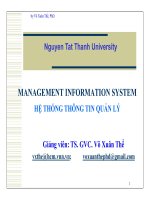Management information system ralp 7e ch02
Bạn đang xem bản rút gọn của tài liệu. Xem và tải ngay bản đầy đủ của tài liệu tại đây (1.26 MB, 43 trang )
• The use of information systems to add value to the
organization is strongly influenced by organizational
structure, culture, and change
• Identify the value-added processes in the supply chain
and describe the role of information systems within them
• Provide a clear definition of the terms organizational
structure, culture, and change and discuss how they affect
the implementation of information systems
Principles of Information Systems, Seventh Edition
2
• Because information systems are so important, businesses
need to be sure that improvements or completely new systems
help lower costs, increase profits, improve service, or achieve
a competitive advantage
• Identify some of the strategies employed to lower costs or improve
service
• Define the term competitive advantage and discuss how
organizations are using information systems to gain such
an advantage
• Discuss how organizations justify the need for information systems
Principles of Information Systems, Seventh Edition
3
• Information systems personnel are the key to unlocking
the potential of any new or modified system
• Define the types of roles, functions, and careers available
in information systems
Principles of Information Systems, Seventh Edition
4
Organizations and Information Systems
• Organization: a formal collection of people and other
resources established to accomplish a set of goals
• An organization is a system
• Inputs to the system: resources such as materials, people,
and money
• Outputs to the environment: goods or services
Principles of Information Systems, Seventh Edition
5
Figure 2.1: A General Model of an
Organization
Principles of Information Systems, Seventh Edition
6
Organizations and Information Systems
(continued)
• Value chain: a series (chain) of activities that includes
inbound logistics, warehouse and storage, production,
finished product storage, outbound logistics, marketing
and sales, and customer service
• Upstream management: management of raw materials,
inbound logistics, and warehouse and storage facilities
• Downstream management: management of finished
product storage, outbound logistics, marketing and sales,
and customer service
Principles of Information Systems, Seventh Edition
7
Figure 2.2: The Value Chain of a
Manufacturing Company
Principles of Information Systems, Seventh Edition
8
Organizational Structure
• Organizational structure: organizational subunits and
their relationship with the overall organization
• Categories of organizational structure:
• Traditional
• Project
• Team
• Multidimensional
• Virtual
Principles of Information Systems, Seventh Edition
9
Traditional Organizational Structure
• A hierarchical structure
• Major department heads report to a president or top-level
manager
• A managerial pyramid shows the hierarchy of decision
making and authority
Principles of Information Systems, Seventh Edition
10
Figure 2.3: A simplified organizational
model, showing the managerial pyramid
Principles of Information Systems, Seventh Edition
11
Figure 2.4: A Traditional Organizational
Structure
Principles of Information Systems, Seventh Edition
12
Project Organizational Structure
• Centered around major products or services
• Temporary project teams
Principles of Information Systems, Seventh Edition
13
Figure 2.5: A Project Organizational
Structure
Principles of Information Systems, Seventh Edition
14
Team Organizational Structure
• Centered on work teams or groups
• Temporary or permanent teams
• Various sizes
Principles of Information Systems, Seventh Edition
15
Multidimensional Organizational
Structure
• May incorporate several structures at the same time
• Advantage: ability to simultaneously stress both
traditional corporate areas and important product lines
• Disadvantage: multiple lines of authority
Principles of Information Systems, Seventh Edition
16
Figure 2.6: A Multidimensional
Organizational Structure
Principles of Information Systems, Seventh Edition
17
Virtual Organizational Structure and
Collaborative Work
• Employs individuals, groups, or business units in
geographically dispersed areas
• People may never meet face to face
• Can be permanent or temporary
• Collaborative work: managers and employees can
effectively work in groups around the world
Principles of Information Systems, Seventh Edition
18
Organizational Culture and Change
• Organizational culture: Major understandings and
assumptions for a business, corporation, or organization
• Organizational culture can significantly influence
information systems
• Organizational change: deals with how organizations
plan for, implement, and handle change
Principles of Information Systems, Seventh Edition
19
Reengineering
• Process redesign
• Radical redesign of business processes, organizational
structures, information systems, and values of the
organization to achieve a breakthrough in business results
Principles of Information Systems, Seventh Edition
20
Figure 2.8: Reengineering
Principles of Information Systems, Seventh Edition
21
Continuous Improvement
• Constantly seeking ways to improve business processes
• Benefits:
• Increased customer loyalty
• Reduced customer dissatisfaction
• Reduced opportunity for competitive inroads
Principles of Information Systems, Seventh Edition
22
Table 2.2: Comparing Business
Process Reengineering and
Continuous Improvement
Principles of Information Systems, Seventh Edition
23
Technology Diffusion, Infusion, and
Acceptance
• Technology diffusion: measure of how widespread the
use of technology is in an organization
• Technology infusion: extent to which technology
permeates a department
• Technology Acceptance Model (TAM): specifies factors
that can lead to higher usage of technology in an
organization
Principles of Information Systems, Seventh Edition
24
Total Quality Management
• Quality: ability of a product or service to meet or exceed
customer expectations
• Total quality management (TQM): approaches, tools,
and techniques that foster a commitment to quality
throughout the organization
Principles of Information Systems, Seventh Edition
25









